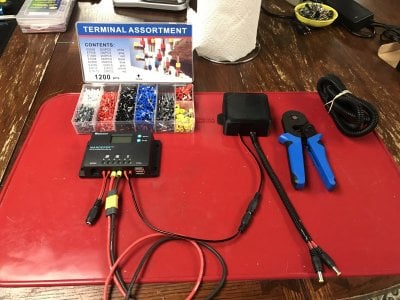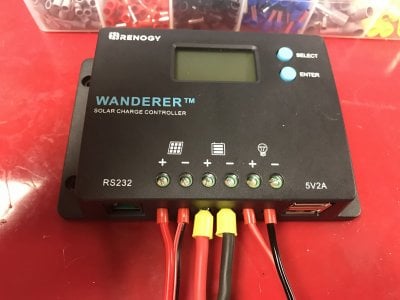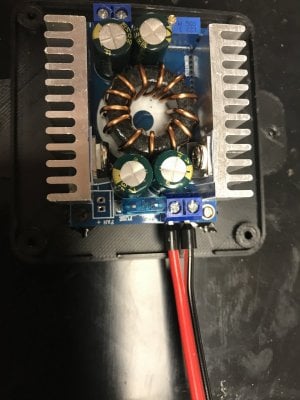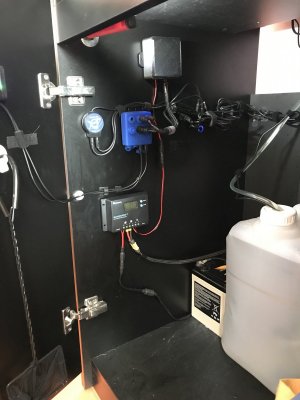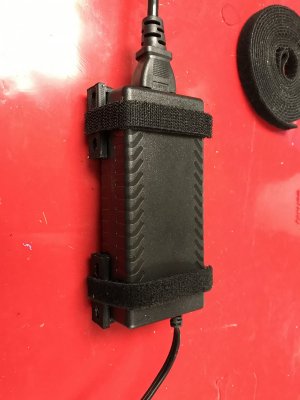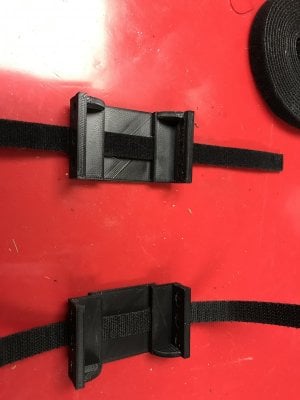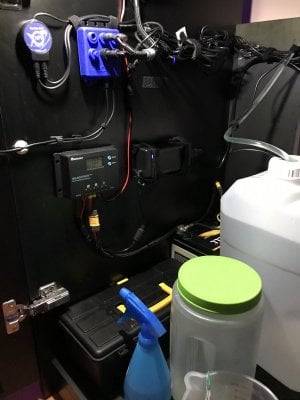I had posted this in my build log and several people thought I should do a writeup on it so here it goes. Sorry if it is long winded I never wrote up a diy. (Disclaimer I’m not an electrical engineer just a hobbyist with some experience tinkering with electronics.)
I stumbled on a simple cheap backup power solution with a pretty robust set of features. You can build a solar generator cheaply and run your DC pumps on it. A pwm solar controller is about $16. That, a battery and a few other components and you have a cool standby backup power solution. I spent about $45 not including battery for mine.
If you are a skimmer you can skip to the end, there is a lot of background stuff coming up.
Background
I have been researching backup solutions and honestly the information is well vague and lacking in many areas. The common theme is that it is super important to have a backup, and best if it is for circulation pumps. There just aren’t a lot of complete solutions.
Being new to reefing I discovered that a tank only has a short window of time where it can be without any life support. As a rule of thumb, the way I see it, after 4 hours without life-support, things are at least stressed but can start dying. 6 hours they do start dying, 12 you get to start a fresh tank. Worst part is even if fish and coral survive the outage, the stress or effects from hypoxia could kill them in the days to come.
I actually have a generator, but I must be home to hook it up. Let’s say power goes out 1 hour after I leave for work (or my GFCI trips). By the time I get home and discover the power was out, I’m now in the die-off\stressed window. Second issue I face is my town requires I shut off the generator at 10:00pm until 6:00am so now I have another 8 hours without life support. Sure, I can get out the spatulas and buckets, but honestly my tank is toast at that point.
So that left me looking for a solution for 4-24 hours of no power.
Currently there are three basic backup systems I keep seeing.
I personally decided to build one and try it out. However, I later found a commercial off the shelf unit that does the same thing but with no tinkering (where is the fun in that). I will share that at the end of the post. Cool fact, if I don’t like how it works out, I can take it camping instead.
Both solutions :
Important! Building something yourself can be satisfying and fun. However there are risks you need to be aware of and accept. You are working with electricity you can get shocked or start a fire if you don't know what you are doing. DIY systems don't go through extensive testing the commercial systems do and can fail in ways we don't plan for. You need to be ready for these hiccups. This is not a step by step guide. If you decided to build your own system, you will need to know how to connect them properly. Please refer to the manufactures instructions.
A solar generator is basically this plus a 100w solar panel. For my use I replace the solar panel with a 15v power supply.
 +
+  +
+  +
+
 +
+
I can also connect a solar panel for an extended outages.
The super easy solution is a commercial off the shelf system that does basically everything my DIY did and more. (I’m not specifically pointing to any particular brand but providing an example of a complete system.)

Why I like this.
* For 24v you would need a boost converter, but they are like $20 and some pumps include them.
Both of these systems I could plug this into AC and leave it connected to my pump via the DC output. When the power is out it switches to battery with a nice display with lots of good info. If I wanted to, I can add a solar panel and extend the runtime. Easy peasy.
I have my system built and I am testing it now. If satisfied I will mount it permanently. One nice thing I discovered is you can see the current voltage of the battery and if it is charging or not.
Two pumps running in alternating wave mode pulled just under 1 amp.
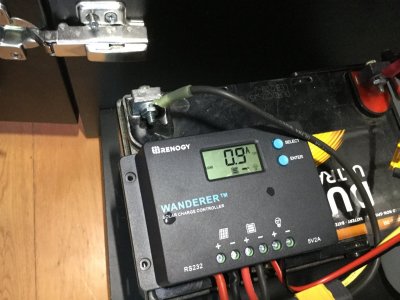
Here it is installed and connected to the two power inputs of my efflux pumps. (temp install so I can continue to tweak it. I plan to do more work on it and rout cable etc.)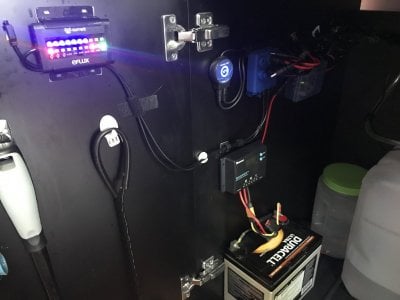
I ran it all night and it barely used any battery. I installed the power brick today and after running the battery down (charged Lipos with it all day) . It can still charge the battery and power the pumps. So it is working. I have a cheap backup solution.
Hope this helps. Please feel free to comment if I missed something.
I stumbled on a simple cheap backup power solution with a pretty robust set of features. You can build a solar generator cheaply and run your DC pumps on it. A pwm solar controller is about $16. That, a battery and a few other components and you have a cool standby backup power solution. I spent about $45 not including battery for mine.
If you are a skimmer you can skip to the end, there is a lot of background stuff coming up.
Background
I have been researching backup solutions and honestly the information is well vague and lacking in many areas. The common theme is that it is super important to have a backup, and best if it is for circulation pumps. There just aren’t a lot of complete solutions.
Being new to reefing I discovered that a tank only has a short window of time where it can be without any life support. As a rule of thumb, the way I see it, after 4 hours without life-support, things are at least stressed but can start dying. 6 hours they do start dying, 12 you get to start a fresh tank. Worst part is even if fish and coral survive the outage, the stress or effects from hypoxia could kill them in the days to come.
I actually have a generator, but I must be home to hook it up. Let’s say power goes out 1 hour after I leave for work (or my GFCI trips). By the time I get home and discover the power was out, I’m now in the die-off\stressed window. Second issue I face is my town requires I shut off the generator at 10:00pm until 6:00am so now I have another 8 hours without life support. Sure, I can get out the spatulas and buckets, but honestly my tank is toast at that point.
So that left me looking for a solution for 4-24 hours of no power.
Currently there are three basic backup systems I keep seeing.
- The basic battery and cable you connect to your DC pump when the power goes out (no standby power).
- The UPS and modified UPS with a cable connected the UPS battery to power DC. (UPS charges battery and powers pumps)
- Commercial battery backup with a y cable (connecting battery, pump and pumps power supply) to provide standby power
- Just plugging a battery into your pump works well doesn't provide standby power. (I have this setup now). You must be home to hook it up (same limitation as my generator).
- UPS systems often only run for a few hours. They have small batteries and a lot of overhead that consumes your reserve power.
- Current backup products are not designed with the life of the battery in mind. They use a y cable that plugs the pumps power brick into one end, the battery into the other then into the pump itself. I am not sure if they even have a diode to prevent reverse current to the battery. In the case of a 12v pump it will draw the battery down to 12v (which is dead a full battery is close to 14v). A 24v pump it will over charge the battery eventually destroying it. Now when you need them, they either don't work or work for a very short time. I suspect these solutions were an adaptation of connecting a Plug directly to a UPS battery for DC power.
- Current commercial products are often designed around a specific product.
- Provide DC power to a load for X amount of time.
- Tend the battery when not in use prolonging the life.
- Charge the battery when it is depleted.
- Provide some isolation for the battery from the normal power supply.
- In some case provide temporary AC power that can be switched off
I personally decided to build one and try it out. However, I later found a commercial off the shelf unit that does the same thing but with no tinkering (where is the fun in that). I will share that at the end of the post. Cool fact, if I don’t like how it works out, I can take it camping instead.
Both solutions :
- Automatically switch to battery when power is lost.
- Provide DC power to a load for X amount of time (time depends on the battery size and pump wattage).
- Shut the power off when the voltage gets to low (damaging the battery)
- Charge the battery when it is depleted
- Tend the battery when not in use prolonging the life of the battery
- Provide some isolation for the battery from the normal power supply.(they actually eliminate the normal power supply.)
- In some case provide temporary AC power that can be switched off
- Both can be run from wall power and still run the DC output and tend the battery.
- Add a solar panel to recharge the battery (and continue to power the pumps as long as the wattage is not to high)
Important! Building something yourself can be satisfying and fun. However there are risks you need to be aware of and accept. You are working with electricity you can get shocked or start a fire if you don't know what you are doing. DIY systems don't go through extensive testing the commercial systems do and can fail in ways we don't plan for. You need to be ready for these hiccups. This is not a step by step guide. If you decided to build your own system, you will need to know how to connect them properly. Please refer to the manufactures instructions.
A solar generator is basically this plus a 100w solar panel. For my use I replace the solar panel with a 15v power supply.
 +
+  +
+  +
+


- The first component is a 15v (or 16v) 6 amp UL or other safety rated ac power supply ($15 on amazon) with a ground.
- The second component is the brains of the system, a negative ground solar controller to tend\charge the battery and manage the load. (this is why the PSU is a least 15V). Very important! Note: The controller must state its a negative ground one, or it will short out when you plug it into the power brick
- The third unit is a 12v to 24v step-up (boost) converter. (This one is overkill but cool, any voltage from 9-15 in comes out at exactly 24v (I really like it). My eflux pumps are 24v so it is required to step 12v to 24v.
- The AGM battery is 35 amp hours (420 watt hours). Its a little big for my needs but I have one on hand since I no longer need it at the RC club. My pumps are 10 watts at 100% and this should run them for 28 hours ( deep cycle batteries can be discharged to 80% capacity). Since I run my pumps less than 50% of total power it could fun for 48 hours. You could use your choice of battery. I eventually plan to use a lithium battery. This controller can charge them as well.
- last but not least 5.5x2.1 mm barrel connectors to hook up the pumps.
I can also connect a solar panel for an extended outages.
The super easy solution is a commercial off the shelf system that does basically everything my DIY did and more. (I’m not specifically pointing to any particular brand but providing an example of a complete system.)

Why I like this.
- This is 400-watt hours. If your pumps are let’s say 35 watts you should get 10ish hrs. at 100% power. Turn them down to 50% and get 20hrs (I don't run my pumps at 100% anyway). My pumps are 10watts so 40hrs is possible.
- This will display and estimate of remaining time based on consumption.
- Can be connected to a solar panel for recharging.
- Has a switchable inverter (it is switched so it doesn't consume power when not used.)
- Pure sine wave inverter (some pumps and equipment only work with pure sine wave inverters)
- Overload and surge protection. Let’s face it, pumps surge when they start and draw more current than you may expect.
- Can recharge with AC or with a solar panel.
- Can continue to power the pumps while charging (if you do not exceed 78watts and have a 100w solar panel. It also adds time to how long it take to charge)
- Can be used for other things in your life when manufactures catch on
* For 24v you would need a boost converter, but they are like $20 and some pumps include them.
Both of these systems I could plug this into AC and leave it connected to my pump via the DC output. When the power is out it switches to battery with a nice display with lots of good info. If I wanted to, I can add a solar panel and extend the runtime. Easy peasy.
I have my system built and I am testing it now. If satisfied I will mount it permanently. One nice thing I discovered is you can see the current voltage of the battery and if it is charging or not.
Two pumps running in alternating wave mode pulled just under 1 amp.

Here it is installed and connected to the two power inputs of my efflux pumps. (temp install so I can continue to tweak it. I plan to do more work on it and rout cable etc.)

I ran it all night and it barely used any battery. I installed the power brick today and after running the battery down (charged Lipos with it all day) . It can still charge the battery and power the pumps. So it is working. I have a cheap backup solution.
Hope this helps. Please feel free to comment if I missed something.
Last edited:





 +
+ 



